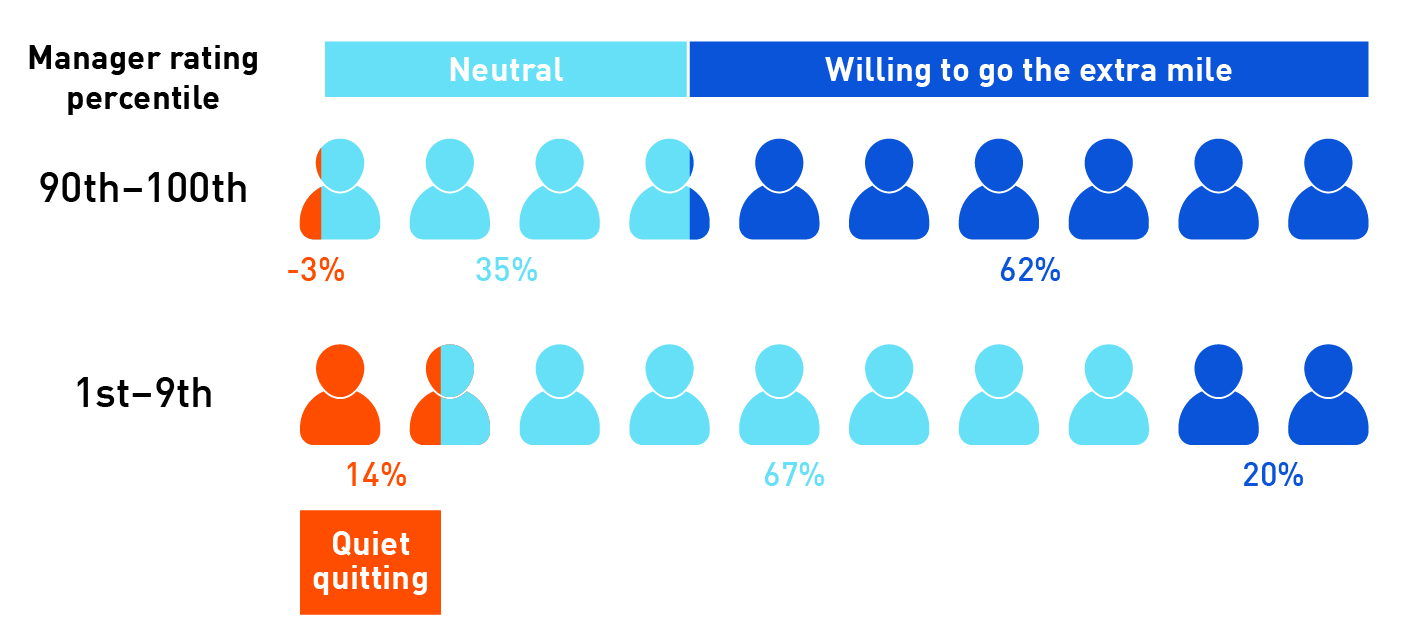
Quiet quitting is the wonderfully named but possibly imaginary trend in which workers collect a paycheck while doing the bare minimum. Gone, according to this trend, are the things we think of as “citizenship behaviours,” all the early-morning-late-night-all-hands-on-deck activities that prove our deep commitment. In their place: the tyranny of Microsoft Teams, and all those little yellow lights that offer dim traces of the colleagues (“last seen 8 m ago”) who seem never to be available.
Nobody wants a colleague who’s never available.
And nobody wants to be unavailable—at least, nobody who believes that work should be both financially rewarding (the collecting a paycheque part) and purposeful.
So, what do we make of this trend? Are there deeper lessons here about staving off burnout? And what does this mean for the lawyers on your team?
Part 1. Is quiet quitting real?
In a recent article in The Atlantic, Derek Thompson called quiet quitting a fake trend. “What people are now calling ‘quiet quitting’ was, in previous decades, simply known as ‘having a job.’” The data, according to Thompson, suggests a tiny, post-pandemic dip in employee engagement—not a large-scale revolution of workers slipping into incognito mode to play Wordle.
A culture’s predominant fears say something about the times we live in. This may be a reach, but stick with us: in the eighties, there was “satanic panic,” a widespread hoax that coincided with the rise of two-parent incomes and a generation of kids who were suddenly (uncomfortably) unmonitored. Today, employers’ fears about quiet quitting—and the corresponding rise in tools that can measure, for instance, an employee’s keystrokes—hint at all the unknowns associated with remote work. If we can’t see them, they must be slacking. If there’s no one around to see it, wouldn’t you expect a tree to just kind of stand there?
Read more: Seeing the laptop half-charged: The good and bad of long-term remote work
Indeed, most articles about quiet quitting (including this one) are pitched at leaders, not the workers who are allegedly in the other room anyway, watching Judge Judy.
As for those leaders, Harvard Business Review states that disengagement has more to do with bad leaders than bad employees. No surprise here: the leaders who are best at balancing “getting results with [showing] a concern for others’ needs” lead teams that are significantly more willing to go the extra mile.
Compare the best managers to the worst1:

Part 2. How to go the extra mile for your team
Workforce data suggests that just as the term was trending, lawyers weren’t “quietly quitting,” but actually quitting. Loudly.
According to the 2022 Report on the State of the Legal Market, “Attorney turnover [rose] to record levels [in 2021],” when the average US firm lost 25% of its associates to a competitor. The data is harder to come by in Canada, but a February 2022 article in CBA Magazine entitled “Please don’t go” suggests that Canadian firms might have been facing even tighter pressures. “The attrition rate [in Canada] might be higher,” said Warren Smith of Smith Legal Search in Vancouver, “because I know a lot of US…firms are coming here to recruit.”
Job markets have since cooled on both sides of the border, but the lesson remains: lawyers who don’t have a combination of meaningful work and meaningful recognition will leave when given the chance.
Here are three ideas to help you balance getting results with showing that you care:
1. Invest in an employee engagement survey
Twenty years ago, Enterprise Rent-a-Car revolutionized its customer service model by asking customers a single question at the end of every transaction: “How likely are you to recommend us to your friends or family?” The average of all these answers—ranging from 1 for “over my dead etc.” to 10 for “extremely likely”—gave the company a net promoter score, an easy metric for tracking the health of their business.
Ask your staff how likely they are to recommend your firm as a place of work, and you’ll have a metric that does the same.
2. Invest in your employees with a group benefits plan that puts them first
In the same CBA Magazine article mentioned above (“Please don’t go”), writer Doug Beazley makes an emphatic case for firms to “concentrate on quality-of-life factors if they want to keep their staffing levels secure.” Group benefits—coverage for things like prescription medication, dental care, massage therapy, and basic life insurance—are key to that equation.
3. Invest in your employees’ futures with retirement income for life
70% of Canadian workers would take a pension over a raise, and 79% say they’d change jobs for a better pension plan.2 A defined benefit pension plan can help you attract and retain talent, with the (not-so-fringe) fringe benefit of also helping you save for your own retirement.
We can help.
Talk to a team of experts about an employee retention strategy that will never quit. Ask an employee benefits specialist about a plan that will reward your team and respect your budget. And ask a pension specialist about a defined benefit pension plan.
Book an employee benefits meeting
Illustration by Adam Rankin
Sources: 1. Harvard Business Review, “Quiet quitting is about bad bosses, not bad employees,” August 21, 2022. The data in this chart comes from US-based Zenger Folkman Analysts. Between 2020 and 2022, the research firm asked 13,048 US workers to rate their 2,801 leaders on two data points: their manager’s ability to balance results with empathy, and the extent to which their work environment is a place where people want to go the extra mile. 2. Thomson Reuters, “2022 report on the state of the legal market: despite a strong year, numerous & growing challenges confront law firms,” January 2022.


